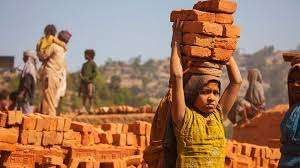
Impact of Globalization on Child Labour
Pr. Biju Eapen
Introduction
The term “Globalization” has been widely used in the last few decades. It has been defined in several different ways. Globalization indicates that the world today is more interconnected than before. Globalization in its basic economic sense refers to the adoption of open and unfettered trading markets.
Some identify it as a new emergence of a “global village.” In the past two decades, economic globalization has been the driving force behind the overall process of globalization. These dimensions can reflect or contribute to the exclusion of the economically and educationally poor people especially in developing countries, and environmental degradation, as well as the growth of prosperity and peace in some areas. Proponents and opponents of globalization have described and emphasized these different aspects. In a capitalistic market, multinational companies are taking the lead in establishing themselves and creating a major presence in almost every part of the world. Slowly but steadily the food that we eat, the clothes we wear and our lifestyle – all begin to change. At one level it may appear that globalization has no significant impact on children and that our lives are ‘normal’ in most circumstances.
Most people are totally unaware of how they form a crucial part of this phenomenon. The reality is that every single individual is affected, one way or another. These changes affect people’s identities and cultural values, which sometimes alters significantly the lives of children. This article tries to view the impact of globalization on child labour.
The current wave of globalisation started soon after the end of the Second World War, but advanced in the 1980’s, as rapid progress in information and transport technology compounded the effects of trade liberalisation. Globalizations have had some positive and major negative impact. Industrialization helped in reaping the maximum advantage of the prevailing labour conditions, selected technological and cultural globalization and increasing consumerism impacted the people, communities, nations, values, even social behaviour. On the global front, all this has led to marginalization of the poorer countries of the world. On the positive side, it enabled people to migrate to places with more opportunities, investment in other national economies, imports, internet etc. On the negative side, globalization along with the concomitant intensely fierce market economic undermined the interests of the weak, poor and vulnerable segments of society, like children.
The impact is directly felt on the children of the poorer households leading to increased child labour activities. Such pushing of the children in the labour market at early age is found in most of the third world countries especially in India.
Impact of Globalization on Children
The impact of globalisation on children is a complex and still largely unexplored topic.
The impact of globalis-ation on child well-being varies depending on various factors. The world’s children have by far the largest stake in the effects of globalisation. One of the major issue faces in developing countries is child labour due to globalization. Globalization has inflated child labour. Globalization, privatization and liberalization and its consequence to human society have adversely affected the physical and mental development of children. It acts as a device to promote child labour practice. In the capitalist dominated industrialized process, profit maximization has become the prime objective of the society.
Child labour helps employers to maximize profits at minimum cost. Poor economic conditions, the absence of any protection for unemployed adult labour and lack of educational facilities are the factors, which forces parent to send their children to work at a very early age. Cheap labour forces are the basiccomponent of production and as children are easily available with very meagre wages, their employment in industry increases in all sectors. They are engaged not only in households, but in a variety of work sectors in urban centres such as markets (shops), hotels, garages, small scale industries etc. Children in these sectors are considered as cheap labour, sometime producing output equal or more than an adult labour. Employers also prefer children, as they do not form unions. Children are now abused much and treated as a production factor, which has deprived them from their childhood happiness, joy, play, education, affection, independence, emotion and most importantly - their child rights
Child labour in India
Child labour is an enormous problem in India and is deep rooted with poverty. Over 400 million people live below the poverty line and 90 per cent of its active population work in the informal sector. According to the 1991 census, there are 11.2 million working children out of a total 210 million children aged 5-14 years. Amongst them, 9.8 millionare classified as ‘main’ workers and 2.2 million as ‘marginal’ workers.
More than 56 per cent of them are self- employed without any social protection. In urban areas, 82 per cent of children work in the non-agricultural sector such as manufacturing, mining, housing and engaged in all sorts of industrial work. Child servitude is both a tradition and a status symbol in India, particularly involving girls. Child workers are mostly from deprived sections of society: with parents living in urban areas with high unemployment and underemployment, from poor or landless rural communities, minorities and immigrants. Along with these factors, the existence of the caste system and sexual discriminationagainst girls - are also quite common to force children particularly girls to start working from an early age. Child labour is most common in rural areas and mostly in the informal sector. Children often perform hazardous tasks.
Children in Agriculture Sector
The agricultural sector employed 76 per cent of child labour. Out of the 12.7 million full-time child labourers, 35.2 per cent worked as cultivators while 42.5% were agricultural labourers. Children in peasant families grow up assisting the family in various tasks. They assist in secondary agricultural activities - the boys graze cattle, assist in agricultural work, while the girls assist in household chores and looking after young siblings, thus releasing the mother for work outside the home. In all peasant homes, work is an integral part of socialization of the child. In situations of extreme distress, where families have been pauperized and made destitute, children are also sold off into bondage to pay off family debts or just to stave off starvation.
Children in Industry
In industry, children work as full-time workers in the carpet industry, located in the Mirzapur - Bhadohi belt in Uttar Pradesh and in Jammu and Kashmir, the match and fireworks industry in Tamil Nadu, the diamond-cutting units in Surat, the glass industry in Ferozabad, the brassware industry in Moradabad, silk-weaving at Varanasi, the pottery unit at Khurja and the tea plantations of Assam and Bengal. If one were to look at the spatial concentration of child labour, the states of Uttar Pradesh, Bihar, Madhya Pradesh, Andhra Pradesh, Orissa, Karnataka and Tamil Nadu account for most of the child labour in India. Among these states the states of the backward and poverty-stricken heartland of India account for a large percentage of child labour.
Both the proponents and opponents of globalisation have explained the effect of globalisation on child labour with arguments. According to the proponents, theinternational free market will reduce the necessity of child labour with overall economic development through higher income and standard of living. According to the opponents, globalisation increases the opportunity of exploiting cheap labour particularly from poor countries.
Why do the children work?
At the micro level poverty within the family as the major factor behind the prevalence of child labour remains the most accepted theory. It is viewed that every where parents prefer to send their children to school but it is lack of resources that induces the impoverished households to push their children into child labour to meet their basic needs for their survival. It is the world’s poorest nations that mostly account for the child labour population when compared to the richer and affluent countries with relatively higher per capita income and GDP. On the domestic front in India, child labour is more concentrated in the states of Uttar Pradesh, Bihar, M.P, Andhra Pradesh, Orissa, Karnataka and Tamil Nadu.
Present scenario in India:-
Globalisation allowed free flow of goods and capital across the geographical boundary. This has encouraged small and medium production units in and around the industrial corridors where huge number of children are found to be working in most unsafe and unhygienic condition. The proponent of globalization argues that, international free market will reduce the necessity of child labour with overall economic development through higher income and standard of living. But opponents say globalization will increase the opportunity of exploiting cheap labour particularly from poor country.
Economic liberalization commenced in 1991,resulted increase in child labour in India. The decreasing trends of child labour from 1971 to 1991 started showing increasing trends (approximately12%) from 1991 to 2001, which indicates that globalization has encouraged child labour in India. It is generally observed that in the pre-globalization era, children working in non hazardous work in family labour segment to learn the occupation of the family. Most of these children work in wage labour segment and their labour is used for commercial production process or delivering service. More work of long duration is undertaken at very low and meagre wage. Moreover, children in pre globalization era working with families and far always from their homes in the wage labour segment in post globalised era. These children are highly vulnerable to exploitation.
We may say globalization has forced more children into hazardous occupations like brick kiln work, motor garage, hotels and shops, transportations, manual loading and unloading work etc. Though large industries do not directly engage children inside their premises due to fear of law etc a high intensity of child labour is found in ancillaries units, shops and establishments developed around these large units.
Despite prohibition of child labour by the Indian constitution, over 60 to a 115 million children in India work. While most rural child workers are agricultural labourers, urban children work in manufacturing, processing, servicing and repairs. Globalization most directly exploit an estimated 300,000 Indian children who work in industries. Uncounted other children work in less formal sectors, such as the incense industry - used both domestically and exported. Reports indicate that urban Indian children and youth face significant competition and pressure to succeed. Yet, as the joint family system weakens and there is less parental supervision and support (with both parents working), the youth seem more restless and insecure. There are also reports of increase in violent behaviour and aggression especially in urban areas and cities. Globalization and marginalization go hand in hand in India. With millions of poorfarmers, rural labourers, urban unemployed, slum-dwellers, 3 million refugees, 100 million street children, and the millions displaced by ‘the development’ projects, poverty in this era of globalization has assumed new dimensions.
Child labour or the children put to work to generate economic activities is nothing new, nor is it limited to any particular country or region, or a period of history. It also most commonly observed that incidence of child labour is higher wherever the access to primary education is low. Child labour has a lot to do with the primary education system and the provisions thereof. In India, in spite of the Constitutional guarantee under the Directive Principles recognizing free and compulsory education of children in the age group of 6-14 years and now the same as a fundamental right, nearly 80-100 million children are reportedly out of school.
Christian Response
Children are more fundamentally, a divine gift and sign of God’s blessing, in accordance with the very blessing of the creator up on humanity in primal history ‘ male and female’ He created them. God blessed them and said to them; “…be fruitful and multiply and fill earth”( Genesis 1: 27,28). Children were, notably, a centre feature of God’s promise to Abraham by giving him descendant as innumerable as the dust of the earth and the stars in the heaven (Genesis 12:2, 13:16, 15:5). Although children are biological descendants of parents, they are created in the image of God. For they inherited the image of God from Adam and Eve who were created in God’s image (Genesis 1:26,27). Creating both male and female in his own image means that sexuality is a gift of God and God’s will for his creation.
Church needs to understand their special vulnerability and distinctive needs of the children because virtually every country on earth has reaffirmed that child survival and total development are moral and ethical imperatives. Children and childhood have been construed across the world as the ‘golden age’ which is synonymous with innocence, freedom, joy, play etc. The impact of globalization on the incidence of child labour must be addressed in both public and religious talks and evoke passion because it can bring people together to discuss about the exploitation of children on moral and ethical ground and find solutions.




